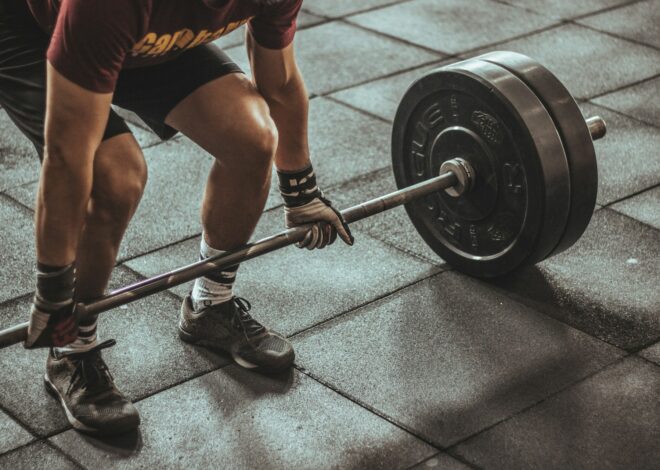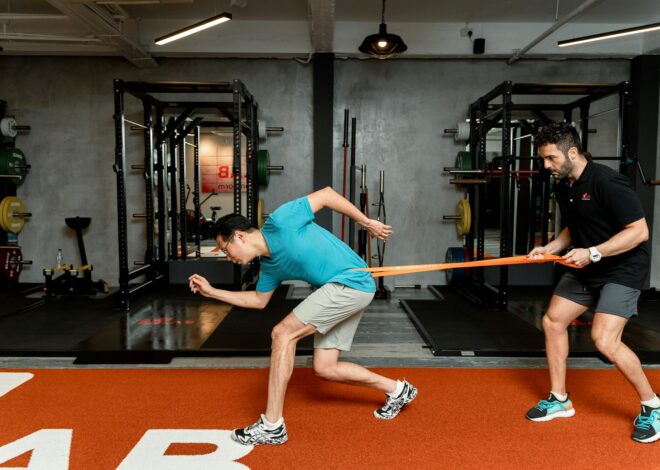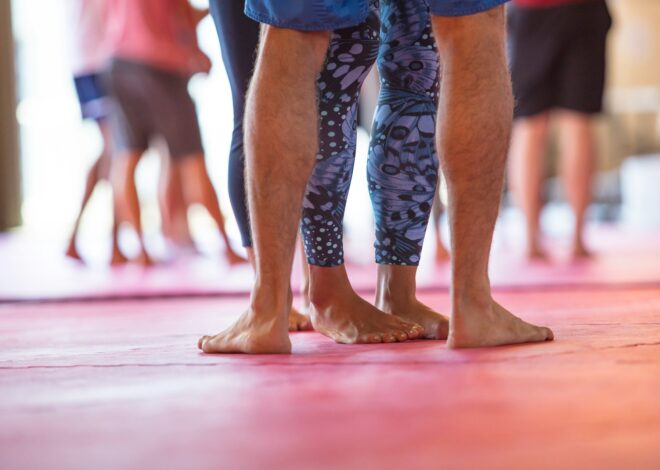
The Best Cross-Training Exercises for Runners to Improve Endurance
Benefits of Cross-Training for Runners
Cross-training offers a myriad of advantages for runners aiming to enhance their overall performance. By incorporating various activities such as swimming, cycling, and strength training into their routine, runners can prevent overuse injuries commonly associated with repetitive pounding on the pavement. The diverse movements engaged in during cross-training help in developing different muscle groups, leading to improved strength and endurance, which are essential for running efficiency.
Moreover, cross-training aids in boosting cardiovascular fitness by challenging the body in different ways compared to running alone. This holistic approach not only elevates aerobic capacity but also allows for active recovery periods, reducing the risk of burnout and ensuring consistent progress in running abilities. Embracing cross-training as a complementary practice to running can lead to a well-rounded athlete, better equipped to tackle the demands of training and races alike.
How Cross-Training Can Improve Running Performance
Cross-training offers a myriad of benefits to runners looking to enhance their performance on the track or the trails. By incorporating a variety of exercises that target different muscle groups and energy systems, runners can improve their overall fitness levels and reduce the risk of overuse injuries. Cross-training helps to address weaknesses, imbalances, and the monotony that can come with solely focusing on running as the primary form of exercise.
Engaging in activities such as swimming, cycling, or strength training not only provides a refreshing change of pace but also contributes to increased cardiovascular endurance, muscular strength, and flexibility. By diversifying training routines, runners can boost their running economy, speed, and stamina. Additionally, cross-training aids in recovery by allowing certain muscle groups used in running to rest while others are being worked, promoting overall muscle balance and efficiency in movement.
The Importance of Building Strength and Endurance
Strength and endurance are crucial components for runners looking to enhance their performance and prevent injuries. Building strength helps improve muscle function and power, which can lead to better running efficiency and form. Endurance training, on the other hand, helps runners increase their cardiovascular fitness and ability to sustain effort over long distances.
By incorporating strength and endurance training into their workout routines, runners can see improvements in their speed, stamina, and overall performance. Developing a strong foundation of muscles and cardiovascular capacity not only boosts running capabilities but also reduces the risk of overuse injuries. It is essential for runners to focus on both strength and endurance to achieve a well-rounded level of fitness that supports their running goals.
Incorporating Cross-Training to Prevent Injuries
To prevent injuries, it is crucial for runners to incorporate cross-training into their exercise routine. Cross-training helps in developing overall strength and stability, which are essential for reducing the risk of overuse injuries commonly associated with running. By engaging in activities that target different muscle groups and movement patterns, runners can enhance their physical resilience and minimize the impact of repetitive stress on their bodies.
Including cross-training activities like swimming, cycling, and yoga can also improve flexibility, balance, and coordination, contributing to better running mechanics and decreased likelihood of injury. Moreover, varying workout modalities through cross-training prevents the body from plateauing and allows for active recovery of strained muscles, allowing runners to maintain a consistent training regimen without overburdening specific muscle groups. By adopting a holistic approach to fitness that includes cross-training, runners can proactively safeguard themselves against the potential setbacks caused by running-related injuries.
Choosing the Right Cross-Training Activities
When it comes to selecting the appropriate cross-training activities to complement your running routine, it is crucial to consider your individual fitness goals and preferences. Opting for activities that target different muscle groups and movements than running can help in enhancing overall strength, endurance, and flexibility. Engaging in a variety of cross-training exercises can also prevent overuse injuries by giving your body the chance to rest and recover from the repetitive stress of running.
Moreover, it is beneficial to choose cross-training activities that align with your interests and personality to ensure long-term adherence and enjoyment. Whether you prefer high-intensity workouts like CrossFit or interval training to boost endurance, or you find solace in low-impact activities such as swimming or yoga for recovery and injury prevention, the key is to find a balance between challenging yourself and finding activities that you genuinely enjoy. By diversifying your cross-training routine, you can enhance your overall fitness levels and improve your performance as a runner.
Cardiovascular Cross-Training Exercises for Runners
Running can put a significant demand on the cardiovascular system, making it crucial for runners to diversify their training regimen with cross-training exercises. Incorporating activities like cycling, swimming, or rowing can help improve cardiovascular endurance while reducing the risk of overuse injuries commonly associated with running. These exercises engage different muscle groups and provide a break from the repetitive motion of running, promoting overall fitness and performance enhancement.
To maximize the benefits of cardiovascular cross-training, it is recommended to vary the intensity and duration of the workouts. High-intensity interval training (HIIT) can be particularly effective in boosting cardiovascular fitness and improving running performance. By alternating between short bursts of intense effort and active recovery periods, runners can enhance their stamina, speed, and aerobic capacity. Additionally, mixing up the types of cross-training activities can prevent boredom and keep motivation high, leading to more consistent training and better results in the long run.
Strength Training Exercises for Improved Endurance
Strength training is an essential component of a well-rounded endurance training program for runners. By incorporating exercises that target multiple muscle groups, runners can improve their overall strength and stamina. Compound movements such as squats, lunges, and deadlifts are particularly effective in building lower body strength and endurance, which are crucial for running long distances without fatigue.
In addition to lower body exercises, upper body strength training can also benefit runners by enhancing overall muscle balance and posture. Including exercises like push-ups, pull-ups, and overhead presses can help runners maintain proper form during runs and prevent muscle imbalances that may lead to injury. By incorporating a mix of strength training exercises into their routine, runners can improve their endurance, speed, and overall performance on the road.
Flexibility and Mobility Workouts for Runners
Flexibility and mobility are crucial components of a well-rounded training regimen for runners. By incorporating specific workouts focused on improving flexibility and mobility, runners can enhance their overall performance and reduce the risk of injuries. Stretching exercises targeting key muscle groups such as the hips, hamstrings, and calves can help increase range of motion, prevent muscle tightness, and promote better running mechanics.
In addition to stretching, mobility drills that focus on joint movements and dynamic stretches are beneficial for runners. These workouts aim to improve the body’s ability to move efficiently and fluidly during runs, leading to better running economy and decreased chances of overuse injuries. By including a variety of flexibility and mobility exercises in their training routine, runners can not only boost their performance but also maintain optimal physical health for long-term running success.
Plyometric Drills to Boost Speed and Stamina
Plyometric drills are dynamic exercises that involve explosive movements to enhance speed, power, and stamina for runners. They focus on quick, powerful contractions of muscles, helping runners improve their overall performance. Incorporating plyometric drills into a training regimen can lead to increased running economy and efficiency.
These drills typically involve jumps, hops, and bounds that target the lower body muscles, such as the quadriceps, hamstrings, and calf muscles. By incorporating plyometric exercises into a runner’s routine, they can develop greater leg strength, explosiveness, and muscular endurance. This can translate to improved running mechanics, increased stride length, and faster race times.
Balance and Stability Exercises for Better Running Form
Incorporating balance and stability exercises into a runner’s training routine can significantly enhance running form and overall performance. These exercises help strengthen the muscles that support proper alignment and posture, reducing the risk of injuries caused by imbalances or instability. By improving core strength and proprioception, runners can maintain better control over their movements, leading to more efficient running mechanics.
Some effective balance and stability exercises for better running form include single-leg squats, stability ball planks, and lateral leg raises. These exercises target key muscle groups, such as the core, glutes, and hips, which play a crucial role in maintaining stability and alignment while running. Adding these exercises to a regular training program can help runners develop greater body awareness and control, ultimately leading to smoother and more efficient running strides.
Circuit Training for Increased Cardiovascular Fitness
Circuit training is a highly effective method for improving cardiovascular fitness among runners. This type of workout involves performing a series of exercises in rapid succession with minimal rest in between. By engaging in a circuit training routine, runners can enhance their heart and lung endurance levels while also increasing their overall stamina. The dynamic nature of circuit training keeps the heart rate elevated throughout the session, helping to improve cardiovascular health and fitness over time.
Incorporating a variety of exercises such as bodyweight movements, cardio drills, and strength training exercises into a circuit can provide a comprehensive cardiovascular workout for runners. The fast-paced, high-intensity nature of circuit training challenges the body in different ways, helping to boost overall physical conditioning and endurance. Additionally, the ability to modify the intensity and duration of each exercise in a circuit allows runners to tailor their workouts to suit their individual fitness levels and goals, making it a versatile and adaptable training method for improving cardiovascular fitness.
Interval Training to Enhance Endurance Levels
Interval training is a highly effective method for boosting endurance levels in runners. This type of training involves alternating between high-intensity bursts of exercise and lower-intensity recovery periods. By pushing your body to work at near-maximum effort during the intense intervals, you can train your cardiovascular system to become more efficient at utilizing oxygen and improving overall endurance.
Studies have shown that incorporating interval training into your workout routine can lead to significant improvements in your aerobic capacity and overall performance as a runner. This type of training not only helps increase your VO2 max, but also enhances your body’s ability to clear lactate, allowing you to sustain higher intensities for longer periods of time. Incorporating interval training sessions into your weekly training schedule can help you push past performance plateaus and take your endurance to the next level.
CrossFit Workouts for Runners
CrossFit workouts can be a dynamic and intense addition to a runner’s training regimen. With its focus on high-intensity functional movements, CrossFit can help runners improve their overall strength, endurance, and power. Incorporating elements like weightlifting, bodyweight exercises, and cardiovascular conditioning, CrossFit workouts challenge the body in ways that traditional running alone may not.
For runners looking to enhance their performance, CrossFit can provide a well-rounded approach to training. By engaging in CrossFit workouts, runners can target different muscle groups, improve their cardiovascular fitness, and work on their explosive power—all of which can translate to better running performance on the road or trails. However, it is important for runners to approach CrossFit with caution, ensuring proper form and technique to prevent injuries and maximize the benefits of this challenging workout style.
Swimming as a Cross-Training Activity
Swimming is a highly effective cross-training activity for runners due to its low-impact nature that provides a break from the constant pounding of running on hard surfaces. Engaging in swimming can help runners improve their cardiovascular fitness and endurance levels while also strengthening muscles that are not typically used while running. The resistance provided by the water helps build muscle strength, especially in the upper body, which can contribute to better overall running performance.
In addition to the physical benefits, swimming can also aid in recovery for runners by promoting active rest and reducing muscle soreness. The buoyancy of water supports the body, reducing impact on joints and allowing for a full-body workout that can help improve flexibility and mobility. Incorporating swimming into a runner’s cross-training routine can enhance overall fitness, prevent overuse injuries, and provide a refreshing alternative to traditional land-based workouts.
Cycling for Improved Leg Strength and Stamina
Cycling is a highly effective cross-training activity for runners looking to enhance their leg strength and stamina. The repetitive motion of pedaling helps to target and strengthen the quadriceps, hamstrings, calves, and glutes. By engaging these major muscle groups during cycling sessions, runners can develop more power and endurance in their lower body, which can translate to improved performance on the road or trail.
In addition to building leg strength, cycling also provides a low-impact workout that is gentle on the joints. This makes it an ideal cross-training option for runners who may be recovering from an injury or looking to reduce the risk of overuse injuries. Incorporating regular cycling sessions into a training regimen can help runners maintain their cardiovascular fitness while giving their running muscles a break from the high-impact stress of pounding the pavement.
Yoga for Recovery and Injury Prevention
Yoga can be a valuable component of a runner’s training regimen, offering benefits beyond physical strength and flexibility. By incorporating yoga into their routine, runners can help improve their recovery times and reduce the risk of injuries. The practice of yoga focuses on breathing, mindfulness, and body awareness, which can aid runners in better understanding their bodies and listening to their physical cues.
Furthermore, yoga can help runners address imbalances in the body that may contribute to overuse injuries. By engaging in yoga poses that specifically target areas of tightness or weakness, runners can work towards achieving greater overall balance and alignment. This can not only help prevent injuries but also enhance performance by promoting a more efficient running stride and movement patterns.
Pilates for Core Strength and Stability
Pilates is a popular cross-training activity for runners due to its focus on developing core strength and stability. By engaging the deep abdominal muscles, Pilates helps improve overall posture and body alignment, which can enhance running efficiency and reduce the risk of injuries. Through a series of controlled movements and breathing techniques, Pilates targets the core muscles to build a strong foundation that supports the body during running activities.
Incorporating Pilates exercises into a runner’s training routine can also help increase flexibility and balance, which are essential components for optimal performance. By strengthening the core muscles, runners can improve their overall running form and efficiency, leading to better endurance and enhanced running performance. Pilates offers a low-impact, yet effective way to target specific muscle groups that are crucial for maintaining stability and power while running.
• Pilates focuses on developing core strength and stability
• Engages deep abdominal muscles to improve posture and body alignment
• Reduces the risk of injuries by strengthening core muscles
• Increases flexibility and balance for optimal performance
• Improves running form, efficiency, endurance, and overall performance
• Low-impact yet effective way to target specific muscle groups
Rowing as a Full-Body Workout for Runners
Rowing is a highly effective full-body workout that can benefit runners looking to enhance their strength, stamina, and overall cardiovascular fitness. This low-impact exercise engages multiple muscle groups simultaneously, including the legs, core, back, and arms, making it an ideal cross-training activity for runners aiming to improve their performance on the track or trails. By incorporating rowing into their training regimen, runners can build muscular endurance, increase cardiovascular endurance, and boost their overall physical conditioning.
In addition to its physical benefits, rowing can also help runners prevent injuries by promoting proper form, posture, and alignment. The rhythmic motion of rowing encourages runners to engage their core muscles and practice controlled breathing, which can translate into better running mechanics and reduced risk of overuse injuries. Furthermore, rowing provides a challenging yet low-impact alternative to running, allowing athletes to continue working on their fitness while giving their joints a break from the repetitive stress of pounding the pavement.
TRX Suspension Training for Functional Strength
TRX Suspension Training is an effective way for runners to build functional strength by utilizing suspended straps to perform bodyweight exercises. This type of training targets multiple muscle groups simultaneously, helping to enhance overall strength and stability. By leveraging your own body weight as resistance, TRX exercises challenge your core muscles and improve balance, which are essential for maintaining proper running form and reducing the risk of injury.
Incorporating TRX Suspension Training into your cross-training routine can also help improve your running performance by increasing power and endurance. The versatile nature of TRX allows for a wide variety of exercises that can be customized to target specific areas of weakness or to work on overall strength. Whether you’re aiming to boost your speed, enhance your stamina, or simply become a more resilient runner, including TRX Suspension Training in your workout regimen can be a valuable addition to your training arsenal.
Dance and Aerobic Classes for Cardiovascular Conditioning.
Dance and aerobic classes are popular options for runners looking to improve their cardiovascular conditioning while adding variety to their workout routine. The dynamic movements and high-energy nature of these classes provide an excellent cardiovascular workout, helping to boost endurance and stamina. Engaging in dance and aerobic classes can also help improve coordination, agility, and overall body awareness, which are beneficial for runners aiming to enhance their performance and prevent injuries.
Moreover, participating in these classes can be a fun and enjoyable way to stay physically active and break the monotony of traditional running workouts. The music-driven environment and group setting can also provide motivation and a social aspect to training, which can be beneficial for maintaining consistency and adherence to a regular exercise regimen. Dance and aerobic classes offer a low-impact yet effective way for runners to work on their cardiovascular fitness and complement their running training for a well-rounded approach to overall health and fitness.











